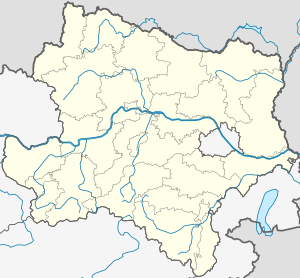Schottwien valley crossing
Coordinates: 47 ° 39 ′ 9 ″ N , 15 ° 52 ′ 12 ″ E
| Schottwien valley crossing | ||
|---|---|---|
| Convicted |
Semmering expressway |
|
| Subjugated | Semmering pass road 4168 | |
| place | Schottwien | |
| construction | Prestressed concrete - box girder bridge | |
| overall length | 632 m | |
| width | 25 m | |
| Number of openings | four | |
| Pillar spacing | 250 m | |
| height | 130 m | |
| start of building | 1986 | |
| completion | 1989 | |
| planner | Otto M. Vogler | |
| location | ||
|
|
||
The Schottwien valley crossing leads the Semmering expressway in Lower Austria over the old Semmering pass road that runs deep below it through the town of Schottwien .
The construction of the Semmering expressway on a completely new route became indispensable due to the steadily increasing volume of traffic on the Semmering pass road. The construction of the valley crossing made it possible to significantly reduce the high traffic load in Schottwien and Maria Schutz .
description
The client, the Autobahn and Schnellstraßen-AG (ASAG) , paid particular attention to the design of the bridge because of the pilgrimage and excursion site of Maria Schutz. Several variants were examined; of the variant finally chosen, models were made in order to be able to assess their integration into the landscape. The Schottwien valley crossing was built between 1986 and 1989 according to a design by Otto M. Vogler by a consortium of the Austrian companies Strabag and Hofmann & Maculan.
The 632.5 m long and 25 m wide bridge has two directional lanes separated by a concrete barrier, each with two lanes and a hard shoulder. It crosses the valley at a height of 130 m. Its four openings have pillar spacing of 77.75 + 162.5 + 250.0 + 142.25 m. The central pillars, which are up to 75 m high, are double pillars at a distance of 25 m; the distance between the pillars' axes is measured from the middle between the two double pillars.
The pillars were made of reinforced concrete in slipforms created, which means that they were each hoisted in a by and thus was no interruption during concreting. They have a hollow cross-section with the dimensions 10.3 × 4.5 m and are monolithically connected to the superstructure.
The superstructure consists of a rectangular, 10.3 m wide, haunched prestressed - hollow box , the pillars on the double a height of 12.0 m has that to the center of the field decreases to 4.2 m. The box girder on pillar 1 is 6 m high. The deck slab cantilevers by 7.0 m on both sides, which is why it is also transversely prestressed. The superstructure was cantilevered , i.e. H. it was made symmetrical on both sides from the pillars in the form of a balance beam. After the cantilever arms were concreted together, the box girder formed a continuous beam , which is only movably supported on the abutments .
Shortly after the opening, small pieces of concrete came loose and fell into the valley. This fact helped that the expression Bröselbrücke became popular. However, the damage was only superficial and could be repaired relatively quickly.
See also
Web links
Individual evidence
- ↑ Otto M. Vogler: The Schottwien valley crossing. In: Beton- und Stahlbetonbau , 84th year, issue 4, April 1989, pp. 91–96 and 121–126
- ↑ Marcel Prade: Les grands ponts du monde . Première partie, Ponts remarquables d'Europe. Brissaud à Poitiers, ISBN 2-902170-65-3 , p. 145
- ↑ Schottwien valley crossing, Austria on tdv.at
- ↑ The pillars are counted here from east (Vienna) to west (Semmering); the photo shows the reverse view

